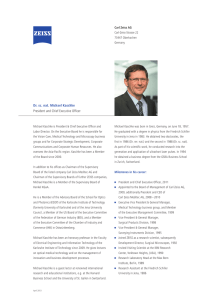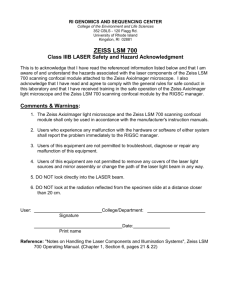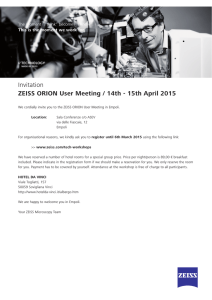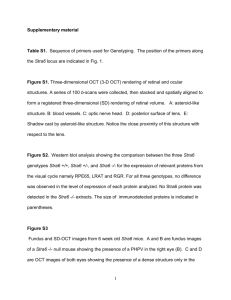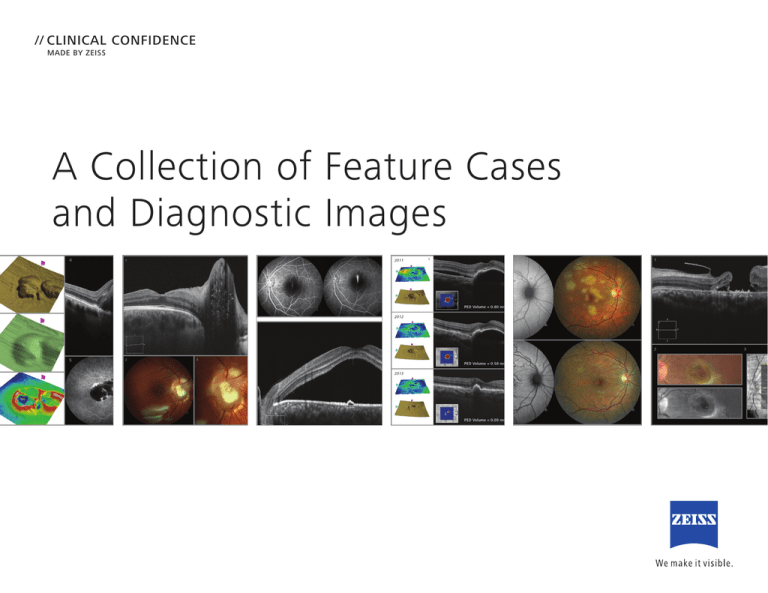
// CLINICAL CONFIDENCE
MADE BY ZEISS
A Collection of Feature Cases
and Diagnostic Images
F E AT U R E D C A S E B Y Z E I S S — A S S E S S A M D
DIAGNOSIS
Exudative AMD with Subretinal Hemorrhage
SUMMARY A 67-year-old patient presented with sudden
onset of central vision loss in the right eye. All
images were acquired on the CIRRUS™ photo
800, which provides versatile visualizations and
a comprehensive view of the patient’s condition.
The fundus photo reveals two foci of subretinal
hemorrhage with varying degrees of thickness and
multiple large soft drusen. The angiogram reveals
blockage due to subretinal hemorrhage and late
leakage due to choroidal neovascularization. The
high-resolution OCT image excellently delineates
disruption of intraretinal architecture, subretinal
blood and pigment epithelial detachment not
visualized on other images. Powered by the
CIRRUS SmartCube™, the segmented layer maps
(Macular Thickness, ILM, and RPE) allow for quick
recognition of any disruptions in the retinal layers.
Images Courtesy of
NC Retina Associates | Bill Gavalier, Ophthalmic Photographer
Captured with ZEISS CIRRUS® photo 800
(1) Macular Thickness Map; (2) ILM Segmentation Map; (3) RPE Segmentation Map;
(4) High-resolution OCT B-scan; (5) Angiogram; (6) Color Fundus
© 2015 Carl Zeiss Meditec, Inc. US_31_025_0073I All Rights Reserved.
F E AT U R E D C A S E B Y Z E I S S — A S S E S S A S T R O C Y T I C H A M A R TO M A
DIAGNOSIS
Astrocytic Hamartoma
SUMMARY A 14 year-old girl was referred for an optic nerve head lesion in
her right eye. She reported occasional discomfort in the right eye
but had no other complaints.
Visual acuity was 20/40 OD and 20/20 OS. Intraocular pressure
was 17 OU and slit lamp exam showed no abnormalities. Dilated
fundus examination of the right eye showed an astrocytic
hamartoma on the optic nerve and an area of myelinated nerve
fiber layer along the inferior arcade. Dilated fundus exam of the
left eye was unremarkable. OCT and color photos, and fundus
autofluorescence were performed. Patient was referred for work
up of tubular sclerosis.
Images Courtesy of
Medical College of Wisconsin
Kimberly Stepien, MD | Mara Goldberg, CRA OCT-C
Captured with ZEISS CIRRUS™ HD-OCT & VISUCAMNM/FA
(1) Smart HD B-scan; (2) Color Fundus; (3) Color Fundus
© 2015 Carl Zeiss Meditec, Inc. US_31_025_0073I All Rights Reserved.
F E AT U R E D C A S E B Y Z E I S S — A M D T H E R A P Y
DIAGNOSIS
Neovascular AMD and associated Pigment
Epithelial Detachment
SUMMARY A 77-year-old patient presented in 2011 with neovascular AMD
and an associated pigment epithelial detachment (PED). This
patient was treated with intravitreal anti-VEGF and demonstrated a
good response to therapy. High-definition OCT raster scans clearly
illustrate the patient’s response to therapy over the period of two
years. However, the subtle effects of the drug observed between
years 2011 and 2012 are more clearly identified by the Advanced
RPE Analysis that demonstrates reduction of the PED and the subretinal fluid. This analysis is based on the CIRRUS™ SmartCube™
scan (512 x 128 or 200 x 200), and provides information on RPE
elevation (area and volume). The Advanced RPE Analysis clinical
application allows careful analysis of PEDs, assessment of change
over time, and the ability to track response to therapy.
Images Courtesy of
Bascom Palmer Eye Institute
Mariana Rossi Thorell, MD | Philip Rosenfeld, MD, PhD
Captured with ZEISS CIRRUS™ HD-OCT
(1) Macular Thickness Map & RPE Segmentation Map;
(2) HD-OCT raster scan & Advanced RPE Analysis
© 2015 Carl Zeiss Meditec, Inc. US_31_025_0073I All Rights Reserved.
F E A T U R E D C A S E B Y Z E I S S — R E T I N O PA T H Y
DIAGNOSIS
Central Serous Retinopathy
SUMMARY A 41-year-old, African-American male presented with
worsening blurry and darkened central vision of two
weeks duration. After clinical and imaging evaluation, the
patient was diagnosed with central serous retinopathy in
the left eye. The high-resolution OCT image clearly shows
substantial subfoveal fluid. The angiogram reveals a classic
area of central pinpoint leakage with smokestack pattern in
later phases. En face OCT shows slab area corresponding to
the central pigment epithelial detachment (PED).
Images Courtesy of
North Carolina Retina Associates | Vivian T. Nguyen, BS
Captured with ZEISS CIRRUS™ HD-OCT
(1) Angiogram reveals central pinpoint leakage with
smokestack pattern in later phases; (2) raster scan shows
subfoveal fluid, while the En face OCT shows the slab area
corresponding to the PED seen in B-scan
© 2015 Carl Zeiss Meditec, Inc. US_31_025_0073I All Rights Reserved.
F E AT U R E C A S E — T R E AT A M P P E
DIAGNOSIS
Acute Multifocal Posterior Placoid Epitheliopathy
SUMMARY A 34- year-old white female presented with a 1-week history of blurry
vision and seeing “black spots” in her vision. She also reported 1 week of
headaches that began concurrently with the visual changes. On exam, she
was 20/25 OU with no afferent pupillary defect (APD). She had
no anterior chamber inflammation but had 1+ vitreous cell OU. Color
fundus photographs at this time reveal deep white retinal lesions scattered
throughout the posterior pole. Fundus Autofluorescence (FAF) revealed
hypoautofluorescent lesions with hyperautofluorescent areas surrounding
the lesions, showing Acute Multifocal Posterior Placoid Epitheliopathy
(AMPPE) lesions. AMPPE is an idiopathic inflammatory condition affecting
the RPE that can be accompanied by cerebral vasculitis (ruled out after
neurologic evaluation).
Since she had subretinal fluid on OCT in her right eye, patient was started
on 60 mg of oral prednisone that was tapered over a 6 week period. Her
symptoms resolved over this time period and she has had no recurrence.
Her vision returned to 20/20 OU. Color fundus photographs (12 weeks
post presentation) reveal resolving AMPPE lesions. The deep white
retinal lesions have become pigmented. FAF from this time also reveals
hyperautofluorescent lesions, indicating resolving AMPPE.
Images Courtesy of
North Carolina Retina Associates | Rebecca Manning, MD; Holly Fields, COA
Captured with ZEISS VISUCAMNM/FA
(1) Initial Presentation: Fundus Autoflourescence, Color Fundus;
(2) 12 Weeks Post Presentation: Fundus Autoflourescence, Color Fundus
© 2015 Carl Zeiss Meditec, Inc. US_31_025_0073I All Rights Reserved.
Note: Patient declined fluorescein angiography due to breast feeding at the time
F E AT U R E C A S E — V I S U A L I Z E R E T I N A L DA M AG E
DIAGNOSIS
Traumatic Macular Hole
SUMMARY Patient suffered a macular hole secondary to blunt trauma. The
brilliant B-scan acquired on the CIRRUS™ HD-OCT allows for
clear visualization of the macular hole with overlying epiretinal
membrane. These data also show neuroretinal thinning on the
nasal side of the hole with hypertrophy of the retinal pigment
epithelium within the hole. The fundus photographs show
amount of pigment loss or RPE damage along with retinal striae.
The en face image provides an additional way to visualize the
retinal damage, more clearly defining the retinal striae in the
internal limiting membrane radiating out from the macular hole.
Images Courtesy of
Flaum Eye Institute University of Rochester
David A. DiLoreto, Jr., MD, PhD | Taylor Pannell, CRA
Captured with ZEISS CIRRUS™ HD-OCT
(1) Hi-definition OCT B-scan; (2) color and red-free fundus images; (3) En face ILM overlay
© 2015 Carl Zeiss Meditec, Inc. US_31_025_0073I All Rights Reserved.
Call for cases and images
If you have a collection of brilliant images taken with a ZEISS imaging instrument and unique cases like you would like considered for use in a
ZEISS publicaiton, please visit www.zeiss.com/best-shot and upload your prize ophthalmic images taken with a CIRRUS™ HD-OCT, CIRRUS photo,
FF450, VISUCAM or other ZEISS retinal imaging device. Submissions considered for use will be eligible for an honorarium.*
Carl Zeiss Meditec, Inc. 800-342-9821
www.zeiss.com/med
© 2015 Carl Zeiss Meditec, Inc. US_31_025_0073I All Rights Reserved.

